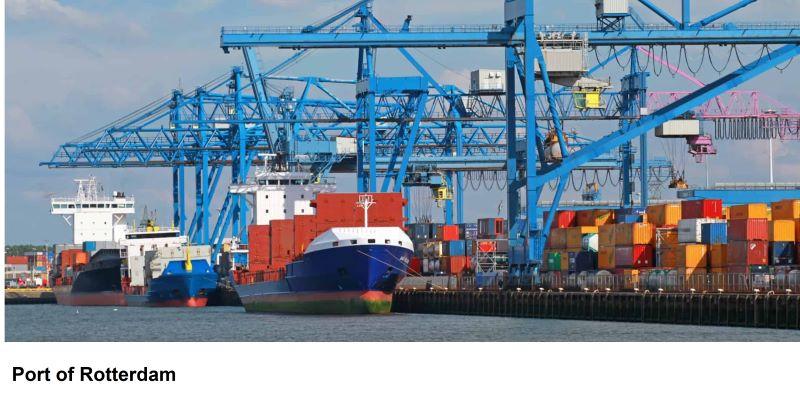Classification of Ports
- Classification of Ports based on Physical Locations
Lake/River Ports (Inland Ports)
- An inland port is a port on a navigable lake, river or canal with access to a sea or ocean, which therefore, allows a ship to sail from the ocean inland to the port to load or unload its cargo.
- Inland ports are ports built on comparatively smaller water bodies such as rivers or lakes.
- They can either be for cargo purpose or for passengers or for both.
- Conventionally Inland Ports are constructed or naturally maintained ports at the coastline of small waterways like lake, river or estuaries and rarely seen at sea coasts too.


Airports
- An airport is an aerodrome with extended facilities, mostly for commercial air transport.
- Airports often have facilities to park and maintain aircraft, and a control tower.
- An airport consists of a landing area, which comprises an aerially accessible open space including at least one operationally active surface such as a runway for a plane to take off and to land or a helipad, and often includes adjacent utility buildings such as control towers, hangars and terminals.
- Larger airports may have airport aprons, taxiway bridges, air traffic control centres, passenger facilities such as restaurants and lounges, and emergency services.
- Airports also handle people and cargo. They are commonly found adjacent to water bodies.


Dry Ports
- Dry ports are defined as inland terminals that can be interconnected with a seaport via road or rail transportation facilities, and they usually act as centres of multimodal logistics.
- A dry port proves useful in the trade of importing and exporting cargo and can help to lessen the inevitable congestion at a nearby seaport.
- Its functions are quite similar to that of a seaport, with the only difference that is not situated near the coastline.
- These are specifically employed for transshipment of cargo to inland destinations.
- Their main purpose is to bring services closer to the customers as a means of decongesting and improving the efficiency of the sea ports.
- Examples: Isaka, Kisumu, ICD, Magerwa


B.Classification of Ports based on Ownership
State owned
- These are common user ports, owned entirely and are under the jurisdiction of the government.
- The Government appoints a Board of Directors to run the port on its behalf.
- These ports are established under an act of Parliament and incomes generated belong to the Government, which has direct control of its capital expenditure.
- Examples of State owned ports are: the port of Mombasa and Dar-Es-Salaam
Municipal Owned Ports
- These ports are owned and managed by the local authorities who undertake construction and maintenance of the facilities.
- Example: Port of Rotterdam.


Private Ports
- Private ports are owned and operated by private Companies.
- In some cases, the Government may own some shares for purposes of control.
- Most of private ports specialize in handling specific commodities e.g. break bulking.
- Private ports are common in USA and Europe, it is anticipated that Kibuye in Rwanda may become a private port for handling Methane Gas terminal.
C. Classification of Ports based on Services rendered
Free Ports
- Freeport is a special kind of port where normal tax and customs rules do not apply. These can be airports as well as seaports.
- At a Freeport, imports can enter with simplified customs documentation and without paying tariffs.
- Businesses operating inside designated areas in and around the port can manufacture goods using the imports and add value, before exporting again without paying the full tariff on the original goods they imported, although a tariff may be payable on the finished product when it reaches its final destination, including if that destination is in the same country outside the Freeport.
Container Ports
- Container terminals are designated for the handling, storage, and possibly loading or unloading of cargo into or out of containers, and where containers can be picked up, dropped off, maintained, stored, or loaded or unloaded from one mode of transport to another (that is, vessel, truck, barge, or rail).
- A terminal is referred to as the set of facilities at a port where loading and unloading of cargo/container take place.
- Terminals are named on the basis of the type of cargo that can be handled by them. Some of the most common types of terminals are container terminal, bulk cargo terminal, Liquefied Natural Gas (LNG) terminal etc.
- Container Ports specifically handle container vessels and containers like in Kenya and Dar-es-salaam they have specific container terminals, Singapore and also Inland Container depots (ICDs) like Nairobi ICD and Naivasha in Kenya.
General Cargo Ports
- General cargo ports handle different types of cargo, which has to be loaded and unloaded by very different mechanical means.
- The port may handle one particular type of cargo or it may handle numerous cargoes, such as grains, liquid fuels, liquid chemicals, wood, automobiles, etc.
- Most cargo ports handle all sorts of cargo, but some ports are very specific as to what cargo they handle.
- The individual cargo ports are divided into different operating terminals which handle the different cargoes, and are operated by different companies, also known as terminal operators or stevedores.
- General Cargo Ports are ports that handle multiple types of goods.
- Examples of these ports include Magerwa in Rwanda, Kenya Ports Authority Berth number 1 – 10 in Mombasa and Berth number 1-8 in Dar-es-salaam.
Gas and Liquid Product Ports
- A liquefied natural gas terminal is a facility for managing the import and/or export of liquefied natural gas (LNG).
- It comprises equipment for loading and unloading of LNG cargo to/from ocean-going tankers, for transfer across the site, liquefication, re-gasification, processing, storage, pumping, compression, and metering of LNG. LNG as a liquid is the most efficient way to transport natural gas over long distances, usually by sea.
- Terminal facilities include jetties and piers with articulated loading / unloading arms for transferring LNG between ship and shore.
- It also includes the piping used to transport LNG between the loading arms and the storage and processing facilities at the terminal.
- Examples of such ports include Dar-es-salaam, Shimanzi in Mombasa and Gatsata in Rwanda.
